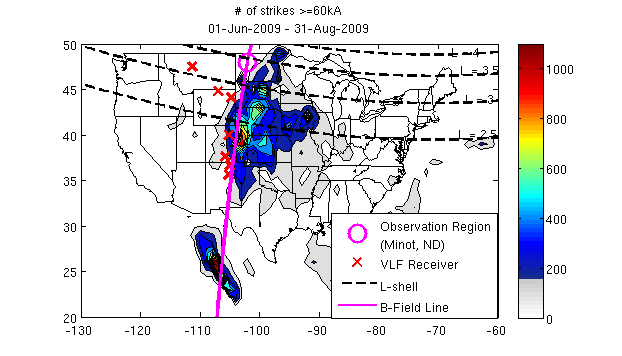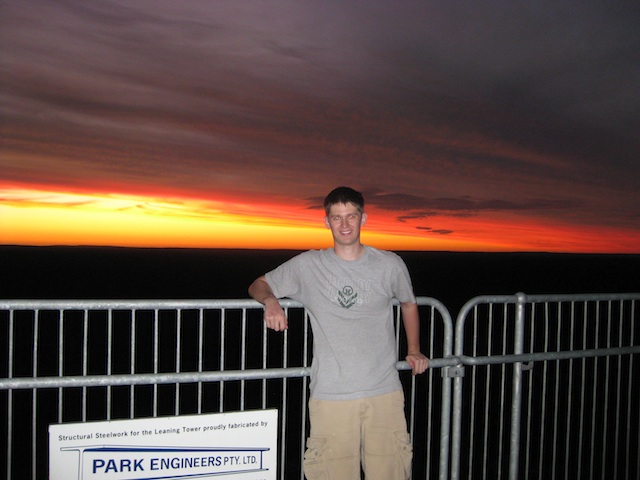Ground Observations of Lightning-Induced Electron Precipitation
Useful Links
PIPER - A photometer designed and built by students to image LEP and TLEs.
TIPER - Transmitter-induced precipitation of electron radiation.
Summary of LEP
Earth's magnetic fields trap energetic electrons to form what are known as radiation belts. These trapped electrons enter into a trajectory which spirals along the field lines, mirrors between the magnetic poles, and drifts eastward around the planet. Electrons can exist in this trapped state for extended periods of time (even years), but they are often pushed out of the radiation belts by waves propagating through the plasmas of the magnetosphere.
The kinetic energy of an electron determines how fast it spirals around a magnetic field line. The number of times an electron orbits a field line in one second is called the gyrofrequency. When an electromagnetic wave with a frequency matching the gyrofrequency of an electron comes into contact with said electron, it changes the mirror point of the electron (this process is called pitch-angle scattering). Electrons with mirror points below about 100 km above the ground enter into a region of the atmosphere which is dense enough that they will almost certainly collide with Nitrogen, Oxygen or other molecules or atoms drifting about. When such a collision occurs, the electron is said to have "precipitated" because it can not return to the radiation belts. A cartoon of this process is presented in Figure 1 below.
The most commonly researched sources of gyroresonant waves in the VLF Group are high-powered communications transmitters and lightning strikes. When a lightning strike occurs it releases an electromagnetic pulse (EMP) of powerful EM waves over a broad range of frequencies, so it is capable of causing many more electrons to precipitate compared to the relatively weak, narrow band of a transmitter. The source of the resonant wave distinguishes two classifications of precipitation: transmitter-induced electron precipitation and lightning-induced electron precipitation (LEP). [Inan, 1987; Walt, 2005; Lauben et al., 2001]

|

|
LEP Research
When groups of electrons precipitate within a region of the atmosphere, they change the shape and conductivity of the earth-ionosphere waveguide through (mostly secondary) ionization of atmospheric atoms and molecules. These transient modifications of the earth-ionosphere waveguide cause noticeable interference in communications transmissions. As a result, there is great interest in better characterizing electron precipitation.
The VLF Group uses two experimental approaches for detecting lightning-induced electron precipitation (LEP). One technique, called VLF remote sensing, monitors VLF transmissions from NAVY transmitters of known frequencies and formats for dramatic disturbances of phase and amplitude (known as "Trimpi events"). This method has proven to be very successful at identifying the presence of electron precipitation, but is not capable of completely characterizing ionization, especially in terms of spatial resolution. To provide more information through other methods of measuring of LEP, optical experiments are underway. When ionization of an atom or molecule occurs, photons (tiny particles of light) are released (as in the aurora, but LEP is much dimmer because fewer electrons are colliding with ionospheric constituents). By capturing these photons with highly sensitive photometers, we hope to measure ionization rates and link them to precipitating electrons. X-rays are also emitted during electron collisions, so instruments which detect X-rays can also be employed to study LEP. [Peter and Inan, 2007]

|

|
Acknowledgements
LEP Research is supported by the Office of Naval Research.
Bibliography
-
Inan, U. S. (1987), Gyroresonant pitch angle scattering by coherent and
incoherent whistler mode waves in the magnetosphere,
J. Geophys. Res., 92(A1), 127-142.
-
Lauben, D. S., U. S. Inan, and T. F. Bell (2001), Precipitation of radiation
belt electrons induced by obliquely propagating lightning-generated
whistlers, J. Geophys. Res., 106(A12), 29,745-29,770.
-
Peter, W. B., and U. S. Inan (2007), A quantitative comparison of
lightning-induced electron precipitation and vlf signal perturbations.,
J. Geophys. Res., 112(A12212), doi:10.1029/2006JA012,165.
-
Walt, M. (2005), Introduction to Geomagnetically Trapped Radiation,
Cambridge University Press.